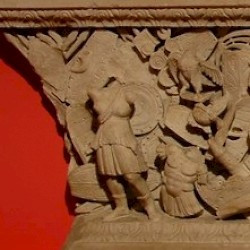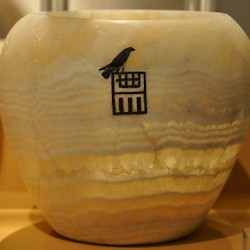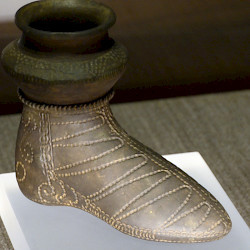Jona Lendering
Jona Lendering read history at Leiden University (MA 1993), specialized in Mediterranean culture at the Amsterdam Free University (MA 1996), and worked at excavations in Holland (Riethoven) and Greece (Halos). After teaching historical theory and ancient history at the Free University for several years, he was one of the founders of a school for history teaching, Livius Onderwijs. Born in Amsterdam, it has now spread to auxiliary locations in Bussum, Dronten, Gouda, Haarlem, Hoorn, Schagen, Zaanstad, and Zoetermeer. As of 2013, Livius Onderwijs has eight teachers, about 500-600 students a year, and offers tours to countries like Italy, Turkey, Iran, and Lebanon. The field trips help to etch into the students' minds some of what they've learned at the school.
Because history is for a large part telling a story, something you do best in your own language, Lendering prefers to publish in Dutch journals. However, he has contributed to the Bryn Mawr Classical Review and Ancient Warfare, while he is the founder of Ancient History Magazine. He is also the publisher and editor of the on-line publication of the Babylonian Chronicles of the Hellenistic Period, a set of important cuneiform sources for the history of the Seleucid and Parthian Near East, transcribed, translated and commented on by Bert van der Spek of the Free University Amsterdam and Irving Finkel of the British Museum. A publication as book is in preparation.
Lendering has written several books and maintains a blog in Dutch. He is the author of several books, including Edge of Empire and Consensus and Crises. For the Livius website, which has received several awards, he collaborates closely with Bill Thayer of LacusCurtius. Lendering is also the webmaster of two daily blogs, the MainzerBeobachter.com and Grondslagen.net.
There are 9380 items in Jona Lendering:

Cumae, Relief with an Amazon |

Cup with the serekh of king Djer |
Curia Julia
Curia Julia: the building of the Roman Senate, where the emperors and the senators met to discuss important affairs. Façade of…Cursus honorum
Cursus honorum: the "sequence of offices" in the career of a Roman politician. A Roman magistrate and two lictors carrying fasces In…Curtius Rufus
Quintus Curtius Rufus (†53 CE): Roman senator, author of an important History of Alexander the Great. Roman man (c.30-50 CE) The main source for the…

Curtuișeni, Shoe-shaped bottle |
Cyaxares
Cyaxares (Persian Uvakhšatara, Akkadian Umakištar): name of a king of the Medes, who may have reigned from c.625 to c.585. Two…Cybele
Cybele (Greek Κυβέλη): Anatolian mother goddess, also worshipped in Greece and the Roman Empire. Ostia, Statue of Cybele The Great Mother was the…Cyclopean Walls
Cyclopean Walls: name for a kind of mortarless Bronze Age wall built with massive boulders. Tiryns, Cyclopean Wall The name "Cyclopean Walls"…Cyclopes
Cyclopes (Greek Κύκλωπες): name of mythological giants who had one round eye, set in the middle of the forehead. The most famous story about a Cyclops is Homer’s tale of Polyphemus, who was blinded by Odysseus.Homeric shepherds …Cylon
CylonCynicism
Cynicism